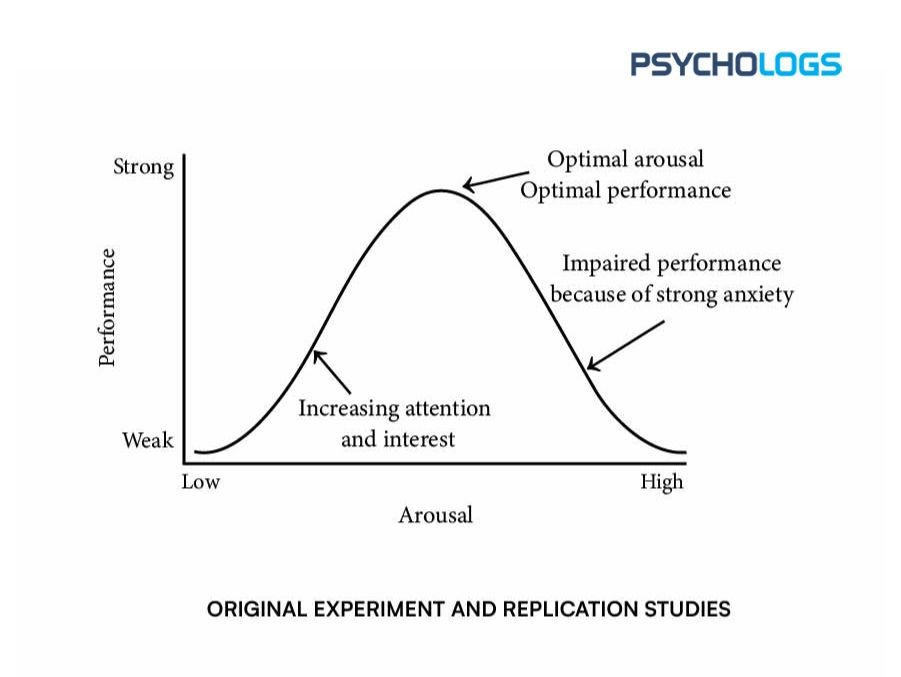People may perform better in some tasks if they have some arousal (stress). For example, a bit of stress during exams helped us perform better. On the other hand, if we had no stress or too much stress, we wouldn’t perform well on our exams. So, we need some kind of arousal to do some tasks but that should be optimal. The Yerkes-Dodson law suggests the same thing that our performance and arousal had a relationship.
Defining
Yerkes-Dodson’s law states that task performance is influenced by stress or arousal levels, with optimal levels leading to peak performance. Very little or too much stress can affect the performance level of the individual. This law has been used since 1908 when the two psychologists Robert Yerkes and John Dillingham Dodson made experiments with mice. Although referred to as a law, Yerkes-Dodson’s law is not a scientific law like other psychological principles. Researchers also describe it as an inverted U-shaped model of arousal.
Yerkes-Dodson law curve
Yerkes-Dodson law can be represented as an inverted U-shaped curve. In the horizontal line, the right side represents the high level of stress or arousal and the left side represents the low level of stress or arousal. The vertical line starts from the weak or low level of performance (bottom) to the high or strong level of performance (top). At the centre of the curve represents the optimal level of performance and the optimal of arousal or stress.
Read more: Understanding Stress: Types, Causes, and Coping Strategies

Robert Yerkes and John Dillingham Dodson studied how stress affects the learning of Japanese dancing mice in the year 1908. The mice were given electric shocks when they entered a white box, but there was no shock provided to them when they entered the black box. With weak levels of shocks, the mice took a longer time to learn to avoid the white box. As the shock strength increased, they learned faster, and when the shocks were too strong they learned slower again. This led to the discovery that a moderate level of stimulus is the best thing for learning.
Replication Studies, after the formulation of the Yerkes-Dodson law, researchers replicated the study with various animals. In 1911, Cole tested chicks with easy, medium, and difficult tasks using different shock levels. For easy tasks, the stronger shocks helped the chicks to learn, while for medium tasks, the strongest shocks slowed the learning of the chicks. For difficult tasks, stronger shocks increased the performance of the chicks. Some chicks learned more quickly than others, and one died.
Cole concluded that his research supported the Yerkes-Dodson law. Another study done by Dodson in 1915 was to train the kittens to differentiate between light and dark boxes using a medium level of shock. Kittens with a medium-strong level of shock performed better than the kittens with a stronger level of shock. When the task was easier for the kittens, both shocks worked well. Dodson moreover found that rewards and punishments were affecting learning.
Read More: How to cope with Exam Stress?
Evaluation of Interpretation
Between the years 1930–1940, the Yerkes-Dodson law provided an understanding that punishment and learning had some relationship. In the 1950s, the law was represented as an inverted U-shaped curve, which indicates that a moderate level of arousal leads to optimal performance, while too much or too little level of arousal affects the performance of an individual. Broadhurst, in 1957, further redefined this result by showing that optimal performance varies with the difficulty of the task and the motivation of the individual.
Reframing the stress
Whenever you feel stressed, your body reacts automatically, your heartbeat increases, your breathing speeds up, and your body temperature rises too high. This is your body gearing up to handle a challenging situation, which represents the positive side of the Yerkes-Dodson law. However, stress also leads to vasoconstriction, tightening our blood vessels, raising blood pressure, reducing blood flow to extremities, and causing fingers and toes to feel cold. This response is bad for you and your performance until you use emotional intelligence to reframe the situation you face. A study in the Journal of Experimental Psychology shows that positively using our stress can help to prevent vasoconstriction, keeping blood pressure normal.
Read More: 6 Tips to Gain Motivation: Be Motivated Even When You Don’t Feel Like It
Conclusion
The Yerkes-Dodson law states that there is an optimal level of stress required to achieve a top level of performance. Too little stress or too high stress makes the performance worse. The best performance happens at a moderate level of stress. This law applies differently for each person, based on their skill level, personality, confidence level, and the complexity of the task. Understanding this balance can help people to manage their stress better and improve their performance in various situations.
FAQs
What is the Yerkes-Dodson law state?
Yerkes-Dodson’s law proposes that the performance of a task and stress or arousal have a relationship. In which an individual can achieve a high level of performance when he or she has an optimal level of stress or arousal. Very little or more stress or arousal affects the performance level of the individual to a worse level.
Who are the people who contributed to the development of the Yerkes-Dodson law?
The Yerkes-Dodson law has been used from the year 1908 when two psychologists named Robert Yerkes and John Dillingham Dodson conducted experiments with mice.
Which experiment leads to the finding of the Yerkes-Dodson law?
Robert Yerkes and John Dillingham Dodson studied how stress affects the learning of Japanese dancing mice in the year 1908. The mice were given electric shocks when they entered a white box, but there was no shock provided to them when they entered the black box. With weak levels of shocks, the mice took a longer time to learn to avoid the white box. As the shock strength increased, they learned faster, and when the shocks were too strong they learned slower again. This led to the discovery of the Yerkes-Dodson law
What is an inverted U-shaped curve?
This law was represented as an inverted U-shaped curve. In the horizontal line, the represents the level of stress or arousal. The vertical line starts from the weak or low level of performance (bottom) to the high or strong level of performance (top). At the centre of the curve represents the optimal level of performance and the optimal of arousal or stress.
Reference +
- MSEd, K. C. (2023, November 22). The Yerkes-Dodson Law and Performance. Verywell Mind. https://www.verywellmind.com/what-is-the-yerkes-dodson-law-2796027
- Psychology Tools. (2023, February 21). Resource | Psychology Tools. https://www.psychologytools.com/resource/performance-and-the-yerkes-dodson-law/
- Simply Psychology. (2023, November 9). The Yerkes-Dodson Law of Arousal and Performance. https://www.simplypsychology.org/what-is-the-yerkes-dodson-law.html
- DiGregorio, T. (n.d.). Yerkes-Dodson Law | Disease Prevention and Healthy Lifestyles. https://courses.lumenlearning.com/suny-monroecc-hed110/chapter/yerkes-dodson-law/
- Pastro, B. (2024, January 6). Stress Less: Utilizing the Yerkes-Dodson Law during exams | Zencare. The Couch: A Therapy & Mental Wellness Blog. https://www.google.com/amp/s/blog.zencare.co/yerkes-dodson-law-finals-stress/amp/













Leave feedback about this